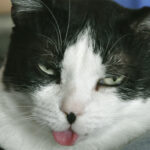Black and white cats are a familiar sight, loved for their striking contrast and diverse patterns. While a solid black coat is genetically common in felines, the addition of white creates a spectrum of beautiful and unique appearances. These bicolor cats, often referred to as “piebald,” are not limited to mixed breeds; they appear across various cat breeds, each showcasing the classic combination in their own way.
You might assume a cat’s breed from its black and white coat, but the colors themselves are more revealing about a cat’s genetic makeup than breed. A closer look at black and white cats reveals fascinating variations in how these colors are distributed, forming distinct patterns across their bodies. Understanding these patterns not only deepens our appreciation for these feline companions but also offers insights into the genetics of coat coloration.
There’s a rich variety within Black And White Cat Types, each with its own charm. Let’s explore the fascinating world of black and white cat coat patterns and learn how to identify them.
Understanding Bicolor Cats
The term “bicolor cat” is an umbrella term that encompasses all cats with coats featuring white alongside another color. “Piebald” is another term often used interchangeably with bicolor, describing animals with pigmented spots on an unpigmented background. While black is a prevalent partner to white, bicolor patterns can also include gray, cream, brown, and other colors. This piebald effect is not unique to cats, appearing in diverse animals like horses, birds, pigs, and snakes.
Genetics dictate these captivating black and white patterns. The presence of at least one allele of the “white spotting gene” is key to a bicolor coat. This gene is incompletely dominant, meaning its expression varies depending on the combination of alleles inherited from the parents.
A cat inheriting two dominant white spotting alleles will typically exhibit white fur covering more than half of its body. Conversely, a combination of one dominant and one recessive allele usually results in a more balanced mix of white and dark fur.
While classifying bicolor patterns isn’t an exact science, feline experts have developed a “white spotting scale” to categorize these patterns:
- Low-grade: Less than 40% white fur.
- Medium-grade: 40%-60% white fur.
- High-grade: More than 60% white fur.
The Cat Fanciers Association uses a more granular scale from 1 to 10, where 1 indicates no white spotting and 10 represents a completely white cat.
The white spotting scale often correlates with the location of white fur. Lower-grade patterns typically show white markings on the chest or belly. As the grade increases, white fur tends to spread, first appearing on the front paws, then the sides, and finally extending to the legs and face. However, this progression is a general guideline, not a strict rule.
While bicolor cats are readily found in shelters, breeders intentionally create pairings to produce kittens with specific black and white patterns. Breeds like the Turkish Van, British Shorthair, American Shorthair, Manx, and Turkish Angora all include bicolor patterns within their breed standards, showcasing the enduring appeal of this classic color combination.
Common Black and White Cat Coat Patterns
Predicting a kitten’s exact coat pattern is challenging, as multiple genes influence the final appearance of bicolor patterns. Distinguishing between different black and white coat patterns can be subjective, but here are descriptions of the most frequently observed markings:
1. Locket
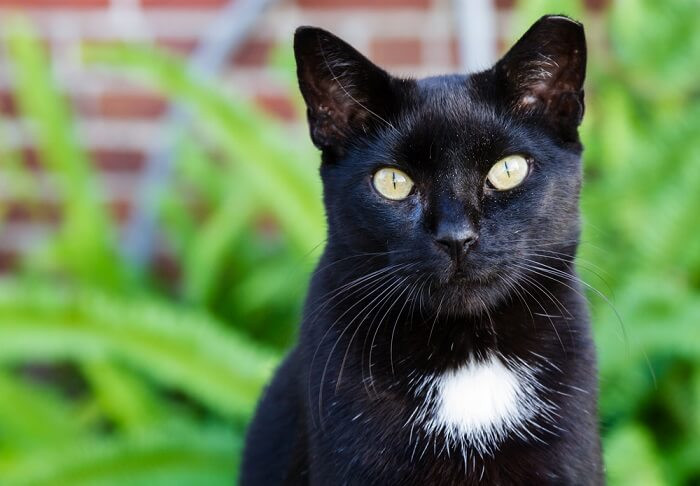 A black cat with a small white patch on its chest, resembling a locket necklace, standing on a wooden floor.
A black cat with a small white patch on its chest, resembling a locket necklace, standing on a wooden floor.
Locket cats fall into the low-grade category on the white spotting scale, characterized by a small, distinct patch of white fur. This white marking can appear as a patch, spot, or a narrow streak, most commonly located on the cat’s chest.
This marking gives the impression of a delicate locket necklace adorning the cat. Sometimes, a small white spot on the stomach may also classify a cat as a locket pattern.
2. Tuxedo
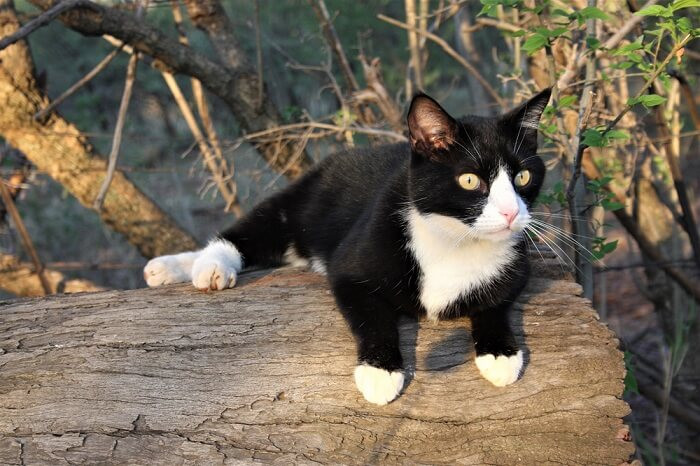 A black and white cat with a classic tuxedo pattern, showcasing white fur on the chest, paws, and face, sitting elegantly.
A black and white cat with a classic tuxedo pattern, showcasing white fur on the chest, paws, and face, sitting elegantly.
Tuxedo cats are arguably the most recognizable and beloved type of black and white cat. Their distinctive pattern features white fur on the chest, belly, and paws, creating the appearance of formal attire.
Often, tuxedo cats also display white markings on their faces, adding to their sophisticated look. It’s important to remember that the “tuxedo” pattern isn’t exclusive to black and white cats. This stylish pattern can also be seen in gray and white cats, and even tabby cats can sport the tuxedo look, demonstrating that elegance comes in various color combinations.
3. True Bicolor
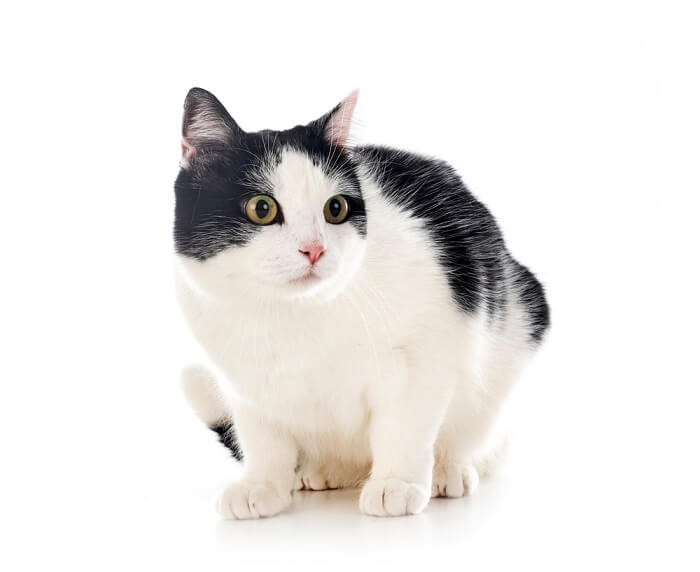 A black and white cat with a true bicolor pattern, displaying roughly equal patches of black and white fur distributed across its body.
A black and white cat with a true bicolor pattern, displaying roughly equal patches of black and white fur distributed across its body.
While “bicolor” broadly describes any two-colored cat, a “true bicolor” specifically refers to cats with an approximately equal distribution of white fur and another color, typically black in this context. These cats fall into the medium-grade category on the white spotting scale. The contrasting colors appear in distinct patches, distributed relatively evenly across the body, creating a balanced and visually appealing pattern.
4. Harlequin
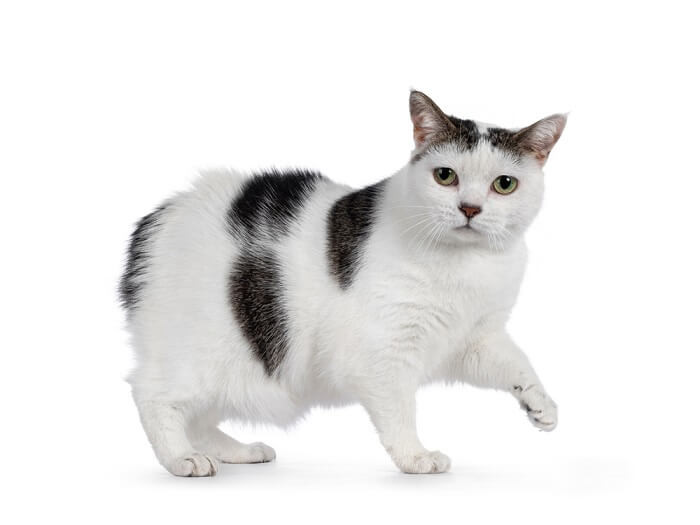 A harlequin cat, also known as a cow cat, exhibiting random black spots and patches over a predominantly white coat, standing on grass.
A harlequin cat, also known as a cow cat, exhibiting random black spots and patches over a predominantly white coat, standing on grass.
Harlequin cats, also playfully known as “cow cats” or even “Dalmatian cats,” display a unique coat pattern characterized by smaller, randomly scattered spots and patches of color, usually black, against a white background. These spots can cover a significant portion of the body, lacking any discernible, repeating pattern. Unlike tabby cats with their stripes or swirls, or tuxedo cats with large, defined color blocks, harlequin cats present a more whimsical, spotted appearance.
5. Mask and Mantle
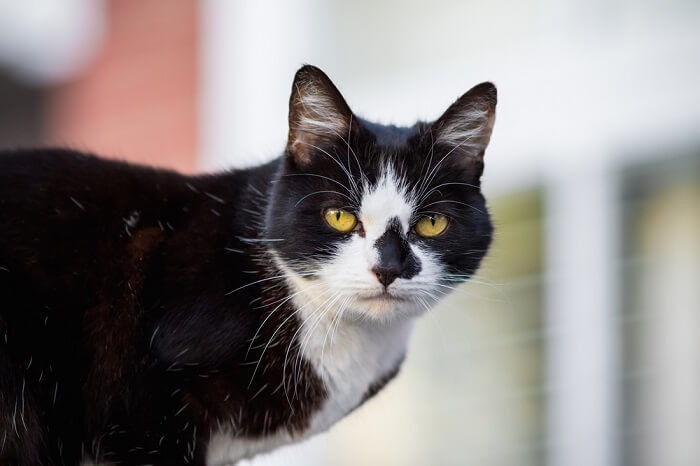 A mask and mantle cat, featuring a black "mask" around the eyes and forehead, and a "mantle" or cape of black fur over the shoulders and back.
A mask and mantle cat, featuring a black "mask" around the eyes and forehead, and a "mantle" or cape of black fur over the shoulders and back.
The mask and mantle pattern describes a specific distribution of color where a cat has dark fur, typically black, around the eyes, ears, and forehead, forming a “mask.” The white fur usually begins at the nose, extending down the chin, neck, and chest. This creates a striking visual effect, reminiscent of a masquerade mask. Some mask and mantle cats also feature a “mantle,” which is a colored area that appears like a cape draped over their shoulders and torso. A cat can have either a mask or a mantle, and some exhibit both, combining for a particularly dramatic look.
6. Cap and Saddle
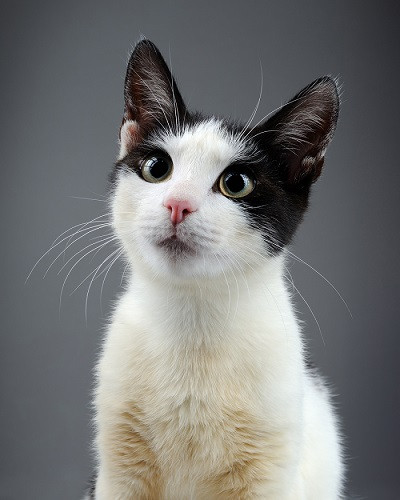 A cap and saddle cat, showing a black "cap" on the top of the head and a "saddle" patch of black fur on its back, sitting on a porch.
A cap and saddle cat, showing a black "cap" on the top of the head and a "saddle" patch of black fur on its back, sitting on a porch.
The cap and saddle patterns share similarities with the mask and mantle, but involve smaller colored areas. A cat with a cap pattern has a patch of colored fur on the top of its head, starting above the eyes, resembling a cap. A saddle is a smaller version of the mantle; this colored patch is located on the back, as if the cat is wearing a saddle, but doesn’t extend to cover the shoulders. These patterns offer a more subtle variation compared to the more extensive mask and mantle.
More Black and White Coat Patterns
Cat coat patterns are wonderfully diverse, and you might encounter black and white cats with markings that don’t neatly fit into the categories above. While less common, these variations add to the fascinating spectrum of feline appearances. The van pattern, for example, is predominantly seen in the Turkish Van breed or cats with Turkish Van ancestry.
Van patterned cats are mostly white with distinct patches of color, usually black, on their heads and often their tails. The rest of their body remains largely white. “Skunk” cats are another less common variation, characterized by a prominent white stripe running down their spine, resembling the markings of a skunk.
Interestingly, changes in black and white coat patterns can also arise from health conditions. Vitiligo, for instance, is a condition that can cause a loss of pigmentation, often appearing on the feet and face, leading to evolving and unique white markings in black and white cats.
Does your feline friend sport a black and white coat? Can you identify their specific coat pattern?

